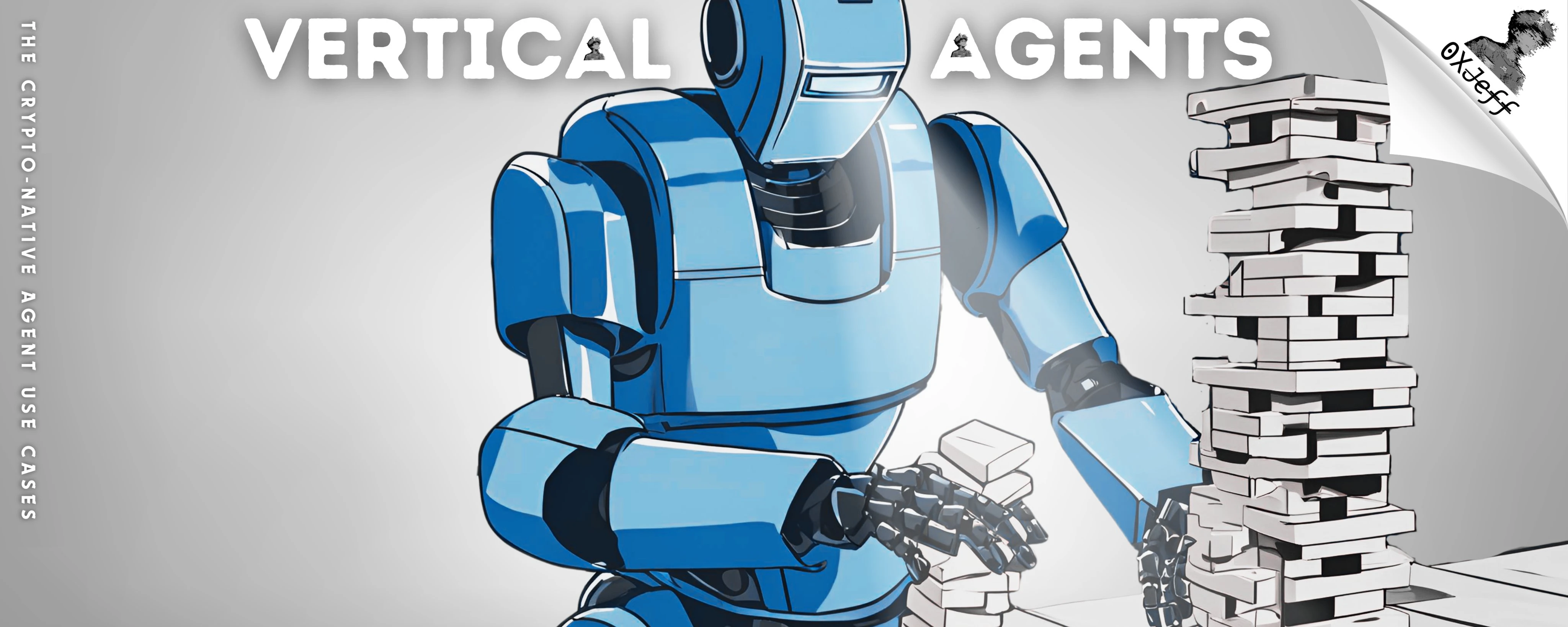Original title: Vertical Agents: The Crypto-Native Agent Use Cases
Original author: 0xJeff (@ Defi0xJeff )
Compiled by: Asher ( @Asher_0210 )

When looking at general application scenarios outside of Web3, many companies, large and small, have begun integrating AI agents into their daily operations, covering almost all areas such as sales, marketing, finance, law, IT, project management, logistics, customer service, workflow automation, etc. This shift makes it unnecessary to manually manipulate data, perform repetitive tasks, and fill out Excel forms. Instead, digital workers (AI agents) are fully automated and work around the clock. These agents not only greatly improve efficiency, but also significantly reduce costs.
In the Web2 space, companies are willing to pay $50,000 to $200,000 or more for AI-driven sales and marketing agents. Many agency providers operate highly profitable businesses through SaaS subscription models or usage-based consumption models.
AI Agent Use Cases in Web2: Insights from YC Startups
Apten is an AI-driven SMS and voice agent designed for automating sales and marketing for B2C businesses. It simulates human communication and can flexibly switch between SMS and voice for seamless interactions.
Bild AI can read building blueprints and extract relevant material and cost data. This technology helps builders and contractors avoid high costs caused by incorrect building plans and reduces unnecessary work and time consumption.
Casixty is a marketing agency that identifies trending topics on Reddit in real time, scans and analyzes website content, and pushes intent-based marketing opportunities to users’ Slack channels.
These examples show how AI agents can effectively transform traditional industries, automate tedious manual tasks, and optimize workflows. In the Web2 space, many companies have quickly adopted AI-driven agents to improve operational efficiency. However, the adoption in the Web3 space has a significant difference: Web3 AI agents not only focus on improving operational efficiency, but also open up new application scenarios and possibilities through the combination with blockchain technology.
Web3 AI Agents: Beyond the Chattering Garbage Bots
A few months ago, most Web3 agents were just chatbots on Platform X. However, the landscape has changed significantly. These agents are now being integrated with various tools and plugins, enabling them to perform more complex operations, specifically:
SendAI : Solana AI Agent Kit enables everything from basic token management to complex DeFi operations;
ai16z : Integrates more than 100 plug-ins, covering social media interactions, automated trading, and decentralized financial operations;
Cod3x , Almanak : No-code infrastructure that allows users to create autonomous trading agents;
Giza : An autonomous DeFi assistant tailored for investors.
As DeFi becomes the largest sector in the cryptocurrency space, with a total locked value exceeding $100 billion, the most influential crypto-native AI agent use cases have also emerged in the DeFi space, forming the so-called DeFAI.
In DeFi, AI agents do more than simplify complex user experiences through natural language processing (NLP) interfaces. They also leverage data on the blockchain to unlock new opportunities and improve efficiency. The blockchain provides a large amount of structured data, including credentials, transaction history, profit and loss records, governance activities, and lending patterns. AI agents can process and analyze this data, extract deep insights, automate workflows, and enhance decision-making capabilities.
By combining blockchain and artificial intelligence, AI agents in the DeFi field can more accurately identify market trends, optimize trading strategies and improve risk management, further promoting the innovation and development of decentralized finance.
Web2 vertical proxies powered by crypto infrastructure
We are also witnessing the emergence of Web2 vertical proxy integration crypto-native models, a typical example of which is the launch of Virtuals Protocol on the Solana ecosystem.
Perspective AI : AI-based fact-checking that is continuously improved through community feedback;
R6D9 : Acts as a personal assistant, booking flights, taxis, ordering groceries and arranging meetings;
HeyTracyAI : AI-based sports commentary and analysis, starting with the NBA.
Unlike the SaaS model, these proxies typically rely on token gating, where users must stake/hold a certain amount of tokens to gain premium access while maintaining free base-tier access. Revenue is generated through token transaction fees and API usage.
Can Web3 AI Agents Compete with Web2 Startups?
In the short term, Web3 teams face the challenge of finding product-market fit and achieving meaningful adoption, and they need at least $1 million to $2 million in annual recurring revenue to compete effectively. However, in the medium to long term, the Web3 model has inherent advantages:
Community-driven growth through token incentives and alignment;
Global liquidity and accessibility, decentralized and non-custodial platforms remove barriers to adoption.
In addition, the rise of DeepSeek and the interest of Web2 AI talents in open source AI have further accelerated the synergy between encryption and AI.
Currently, the application scenarios of crypto-native AI agents include:
DeFAI: Abstraction layer, automated trading agent, staking/lending solutions, which not only serve as the front end of DeFi infrastructure, but also improve the efficiency of DeFi products.
Research and Reasoning Agents: AI-powered research assistance tools that analyze data, remove noise, and generate actionable insights. My favorites lately are security agents, such as:
SOLENG - a developer relations agent that analyzes GitHub repositories.
BevorAI : AI-based auditing service that identifies potential threats (agent scoring system coming soon).
Data-driven AI agents: Using on-chain and social data to drive autonomous decision-making and execution. These three areas represent the most promising application directions for crypto-native AI agents.
summary
The market has been in a consolidation phase over the past month, and while proxy-related tokens and some small cryptocurrencies have experienced significant pullbacks, we are gradually entering a period where the fundamentals of tokens are clearer.
Web2 vertical agents have proven their value, and many companies are willing to pay high fees for AI-driven automation. In contrast, Web3 vertical agents are still in their early stages, but their potential is huge. By combining token-based incentives, decentralized access rights, and deep integration with blockchain data, Web3 AI agents have the potential to surpass Web2 agents in the future. However, the key question remains: Can Web3 vertical agents achieve market acceptance comparable to Web2, or completely reshape the market landscape by fully leveraging the native advantages of blockchain technology?
As vertical AI agents develop in Web2 and Web3, the boundaries between the two may become blurred. Teams that can successfully combine the advantages of both, leveraging the efficiency of AI and the decentralized nature of blockchain, are likely to lead the next generation of automation and intelligent transformation in the digital economy.










